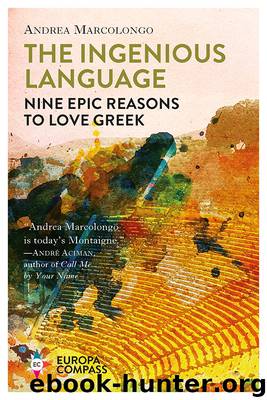The Ingenious Language by Andrea Marcolongo

Author:Andrea Marcolongo
Language: eng
Format: epub
Publisher: Europa Editions
Published: 2019-07-30T16:00:00+00:00
Greek Colors
“How differently the Greeks saw the natural world. Their eyes, we must admit, were blind to blue and green; they saw dark brown instead of blue, green instead of yellow. They used the same term to describe brown hair, cornflower, and the southern sea, the same term for the color of the greenest plants and human skin, the same term for honey and yellow resin. That is why their greatest painters only painted the world in black, white, red, and yellow. How differently and how much closer to humankind must nature have looked to them, since in their eyes the coloration of humankind also preponderated in nature, and nature was swimming, so to speak, in the atmosphere of human colors!” That’s Nietzsche, in aphorism 426 of Daybreak, sizing up the chromatic quirks of the ancient Greeks.
In his Theory of Colors, Goethe remarks on the extraordinary Greek vocabulary for colors, how it stretches the norms—as different from our own as the Greek language is to our language. The Greeks’ associations with colors were so unprecedented that eighteenth and nineteenth century scholars speculated that they didn’t even see colors—as if! Of course they saw them. They just had other ways of expressing them. Rest assured, people’s eyes have always been and always will be the same.
For the Greeks, color was life and light, a human experience rather than a physical or optical one. Far removed from Newton’s color spectrum theory.
In the Iliad and the Odyssey, Homer names just four colors: milk white, blood red, the black of the sea, and the yellow-green of honey and wheat.
The words black (μέλας) and white (λευκός) indicated darkness and light (the Latin word lux has the same etymology of the Greek color). Colors are in fact created, according to the Greeks, by the play of light and shadow.
In Greek, the word ξανθός signifies a color ranging from yellow to red to green: call it verdigris. It is the warm shade of ripe wheat, as well as the blond hair of all those heroes in Homer and the reddish hue of the fire at night or the round orange sun at dusk.
The adjective πορφύρεος means “agitated, in continuous movement, boiling over” and also stands for Tyrian purple, a color that ranges from blood red to just this side of blue. Πορφυρεύς means “purpura shell fishermen,” because the dye was extracted from shellfish and produced by expert dyers.
Cyan (κυάνεος) means blue in general and is applied to everything from azure to dark red to the black associated with death.
Still, my favorite Greek color is glaucous (γλαυκός). Its primary meaning is “bright, gleaming,” and it is used to describe the play of light on the sea. Athena’s eyes are glaucous, “bright as an owl’s,” cerulean, blue, bluish-gray.
The illustrious Homer scholar and British statesman William Gladstone was among the first to insist on the luminous impression of Greek colors. In the decades after him, scholars noted the linguistic “quirks” other civilizations used to map colors, including the language
Download
This site does not store any files on its server. We only index and link to content provided by other sites. Please contact the content providers to delete copyright contents if any and email us, we'll remove relevant links or contents immediately.
| Ancient & Classical | Arthurian Romance |
| Beat Generation | Feminist |
| Gothic & Romantic | LGBT |
| Medieval | Modern |
| Modernism | Postmodernism |
| Renaissance | Shakespeare |
| Surrealism | Victorian |
4 3 2 1: A Novel by Paul Auster(12281)
The handmaid's tale by Margaret Atwood(7678)
Giovanni's Room by James Baldwin(7188)
Asking the Right Questions: A Guide to Critical Thinking by M. Neil Browne & Stuart M. Keeley(5631)
Big Magic: Creative Living Beyond Fear by Elizabeth Gilbert(5610)
Ego Is the Enemy by Ryan Holiday(5292)
The Body: A Guide for Occupants by Bill Bryson(4973)
On Writing A Memoir of the Craft by Stephen King(4863)
Ken Follett - World without end by Ken Follett(4643)
Adulting by Kelly Williams Brown(4485)
Bluets by Maggie Nelson(4472)
Eat That Frog! by Brian Tracy(4430)
Guilty Pleasures by Laurell K Hamilton(4358)
The Poetry of Pablo Neruda by Pablo Neruda(4038)
Alive: The Story of the Andes Survivors by Piers Paul Read(3967)
White Noise - A Novel by Don DeLillo(3953)
Fingerprints of the Gods by Graham Hancock(3938)
The Book of Joy by Dalai Lama(3897)
The Bookshop by Penelope Fitzgerald(3775)
